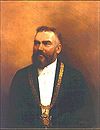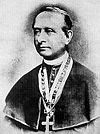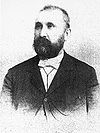- Croatian Academy of Sciences and Arts
-
Croatian Academy of Sciences and Arts
The decorated facade of the Academy Palace, Zrinski Square in ZagrebAbbreviation HAZU Formation 1866 in Zagreb Type National academy Purpose/focus Science, arts, academics Headquarters  Zagreb, Croatia
Zagreb, CroatiaLocation 45°48′33″N 15°58′43″E / 45.80917°N 15.97861°ECoordinates: 45°48′33″N 15°58′43″E / 45.80917°N 15.97861°E Membership 148 full members (as of May 2010[update])[1] Chairman Zvonko Kusić Main organ Presidency of the Academy[2] Budget HRK 76.7 million (€10.5 million) (2010)[3] Website Croatian Academy of Sciences and Arts The Croatian Academy of Sciences and Arts (Latin: Academia Scientiarum et Artium Croatica, Croatian: Hrvatska akademija znanosti i umjetnosti, abbrev. HAZU) is the national academy of Croatia. It was founded in 1866 as the Yugoslav Academy of Sciences and Arts (Jugoslavenska akademija znanosti i umjetnosti, abbrev. JAZU), and was known by that name for most of its existence.
Contents
History
The institution was founded in Zagreb in 1866 as the Yugoslav Academy of Sciences and Arts.[4] The bishop and benefactor Josip Juraj Strossmayer, a prominent advocate of higher education during the 19th century Croatian national romanticism, set up a trust fund for this purpose and in 1860 submitted a large donation to the then viceroy (ban) of Croatia Josip Šokčević for the cause of being able to
“ bring together the best minds [...] and find a way in which books in the national languages could be produced in the Slavic South; the Academy should also take under its aegis all the areas of human science[5] ” After some years of deliberations by the Croatian Parliament and the Emperor Franz Joseph, it was finally sanctioned by law in 1866. The official sponsor was Josip Juraj Strossmayer, while the first Chairman of the Academy was the distinguished Croatian historian Franjo Rački.[5] Đuro Daničić was elected for secretary general of the Academy, where he played a key role in preparing the Academy's Dictionary, "Croatian or Serbian Dictionary of JAZU".
The Academy's creation was the logical extension of the University of Zagreb, the institution initially created in 1669 and also renewed by bishop Strossmayer in 1874. Bishop Strossmayer also initiated the building of the Academy Palace in the Zrinjevac park of Zagreb, and the Palace was completed in 1880.[5] In 1884, the Palace also became a host of The Strossmayer Gallery of Old Masters that contained 256 works of art (mostly paintings).[5] The same is today one of the most prominent art galleries in Zagreb.
The Academy published the scientific magazine Rad (Croatian for "work") between 1867 and 1882, when each of the individual scientific classes of the Academy started printing their own magazines. A total of almost five hundred issues have been printed up to now. In 1887, the Academy published the first "Ljetopis" as a year book, as well as several other publications in history and ethnology.
Ivan Supek, Mihailo Petrović, Dragutin Gorjanović-Kramberger and Lavoslav Ružička were JAZU members.
Name changes
The Academy briefly changed name from "Yugoslav" to "Croatian" between 1941 and 1945 during the Axis client regime of the Independent State of Croatia.
It was permanently renamed "Croatian" in 1991 after Croatia gained independence from Yugoslavia.
Departments
The Academy is divided into nine departments (classes):[6]
- Department of Social Sciences
- Department of Mathematical, Physical and Chemical Sciences
- Department of Natural Sciences
- Department of Medical Sciences
- Department of Philological Sciences
- Department of Literature
- Department of Fine Arts
- Department of Music and Musicology
- Department of Technical Sciences
Membership
See also: List of members of the Croatian Academy of Sciences and ArtsThere are four classes of members:[7]
- Full members
- Associate members
- Honorary members
- Corresponding members
The number of full members and corresponding members is limited to 160 each, while the maximum number of associate members is 100.[7] Number of full members per department is limited to 24. Only the full members may carry the title of "academician" (English: F.C.A., Croatian: akademik (male members) or akademkinja (female members)).
Chairmen
Image Chairman Term Franjo Rački 1866-1886 Pavao Muhić 1886-1890 Josip Torbar 1890-1900 
Tadija Smičiklas 1900-1914 Tomislav Maretić 1914-1918 Vladimir Mažuranić 1918-1921 Gustav Janečak 1921-1924 Gavro Majnolović 1924-1933 Albert Bazala 1933-1941 Tomo Matić 1941-1946 Andrija Štampar 1946-1958 Grga Novak 1958-1978 Jakov Sirotković 1978-1991 Ivan Supek 1991-1997 Ivo Padovan 1997-2004 
Milan Moguš 2004-2010 Zvonko Kusić 2010-present Criticism
The Academy has recently been criticized to the effect that membership and activities are based on academic cronyism and political favor rather than on scientific and artistic merit. In 2006 matters came to a head with the Academy's refusal to induct Dr. Miroslav Radman, an accomplished biologist, a member of the French Academy of Sciences, and an advocate of a higher degree of meritocracy and accountability in Croatian academia. His supporters within the Academy and the media decried the decision as reinforcing a politically-motivated, unproductive status quo.
Dr. Ivo Banac, a Yale University professor and then a deputy in the Croatian parliament, addressed the chamber in a speech decrying a "dictatorship of mediocrity" in the Academy, while Globus columnist Boris Dežulović satirized the institution as an "Academy of stupidity and obedience." Dr. Vladimir Paar and others defended the Academy's decision, averring that it did take pains to include accomplished scientists but that, since Dr. Radman's work has mostly taken place outside Croatia, it was appropriate that he remain a Corresponding rather than a Full Member of the Academy[8]
Ivan Đikić, an accomplished Croatian scientist, working at the Goethe University Frankfurt, and as of 2010 a member of the German Academy of Sciences Leopoldina, had previously not been able to join HAZU even as an associate member.[9] Nenad Ban, a distinguished molecular biologist from ETH Zurich, is another member of Leopoldina who has not been admitted to HAZU.[10]
See also
Notes and references
- ^ http://metro-portal.hr/hazu-od-cetvrtka-ima-devet-novih-clanova/40533 (Croatian)
- ^ "Presidency of the Academy". Croatian Academy of Sciences and Arts. http://info.hazu.hr/leadership. Retrieved 2009-01-15.
- ^ "Financijski plan Hrvatske akademije znanosti i umjetnosti za 2010. godinu" (in Croatian) (PDF). Croatian Academy of Sciences and Arts. http://info.hazu.hr/upload/file/Dokumenti/Financijski%20plan%20akademije%20prilog%20br_2.pdf. Retrieved 2010-10-24.
- ^ The adjective "Yugoslav" was coined in mid-19th century by the movement that sought national unity of the South Slavs from Austria-Hungary with their eastern neighbors. Its extent was likely ambiguous, e.g. in whether or not it meant to include Bulgarians and Macedonians. Later the term became associated specifically with the country and peoples of Yugoslavia.
- ^ a b c d "The Founding of the Academy". Croatian Academy of Sciences and Arts. http://info.hazu.hr/foundation_of_academy. Retrieved 2009-01-17.
- ^ "Classes of Academy". Croatian Academy of Sciences and Arts. http://info.hazu.hr/classes. Retrieved 2009-01-14.
- ^ a b "Members of Academy". Croatian Academy of Sciences and Arts. http://info.hazu.hr/member_of_academy. Retrieved 2009-01-14.
- ^ "Dictatorship of Mediocrity" debate, Feral Tribune, 2006. Banac speech, Paar reply, Banac response Retrieved 2009-10-21 (Croatian)
- ^ "Đikić: Počašćen sam izborom u prestižnu akademiju, ali to je i obvezujuće [Đikić: I'm honored with the election into the prestigious academy, but it is also an obligation]" (in Croatian). Nacional. 2010-09-29. http://www.nacional.hr/clanak/92383/dikic-pocascen-sam-izborom-u-prestiznu-akademiju-ali-to-je-i-obvezujuce. Retrieved 2010-10-18.
- ^ "Uspjeh: Đikića priznali i Nijemci, a u HAZU nije prošao [Success: Đikić recognized by the Germans, but could not enter HAZU]". Večernji list. 2010-09-29. http://www.vecernji.hr/vijesti/uspjeh-dikica-priznali-nijemci-a-hazu-nije-prosao-clanak-196958. Retrieved 2010-10-18. "Dodao je i da je još jedan Hrvat, inače jedan od vodećih strukturalnih biologa u svijetu, Nenad Ban, takoder član Leopoldine u Razredu za biokemiju i biofiziku."
External links
- Croatian Academy of Sciences and Arts (Croatian) (English)
- Zakon o Hrvatskoj akademiji znanosti i umjetnosti (Croatian)
- (Croatian) Milan Moguš - čuvar tradicije Hrvatske akademije - an interview with Milan Moguš in Nacional
- Intelektualna krema pred vratima HAZU-a (Croatian)
- VIJENAC 80 - Svjeza krv u Akademiji (Croatian)
- HAZU: najskuplji starački dom (Croatian)
Zagreb History History of Zagreb · Gradec · Kaptol · Krvavi most · 1880 earthquake · 1995 rocket attacks · Zagreb crisis · MayorsDistricts Brezovica · Črnomerec · Donja Dubrava · Donji grad · Gornja Dubrava · Gornji grad-Medveščak · Maksimir · Novi Zagreb-istok · Novi Zagreb-zapad · Peščenica-Žitnjak · Podsljeme · Podsused-Vrapče · Sesvete · Stenjevec · Trešnjevka-jug · Trešnjevka-sjever · TrnjeBuildings and
landmarks1 Ilica Street · Ban Jelačić Square · Banski dvori · British Square · Cibona Tower · Dolac Market · Grič Cannon · Ilica Street · Jarun · Kallina House · Lotrščak Tower · Maksimir Park · Marshal Tito Square · Medvedgrad · Meštrović Pavilion · Mirogoj Cemetery · Nikola Šubić Zrinski Square · Nine Views · Old City Hall · St. Mark's Square · Tkalčićeva Street · ZagrepčankaChurches Culture Galleries and
museumsArt Pavilion · Croatian Museum of Naïve Art · Glyptotheque · Klovićevi dvori · Mimara Museum · Modern Gallery · Museum of Broken Relationships · Museum of Contemporary Art · Strossmayer Gallery · Technical Museum · Zagreb City MuseumEducation Croatian Academy of Sciences and Arts · University of Zagreb (Academies: Dramatic Art · Fine Arts · Music · Faculties: Economics and Business · Electrical Engineering and Computing · Geodesy · Humanities and Social Sciences · Medicine · Teacher Education)Sports venues Transport Festivals International Council for Science (ICSU) National Members Albania · Angola · Argentina · Armenia · Australia · Austria · Azerbaijan · Bangladesh · Belarus · Belgium · Bolivia · Bosnia & Herzegovina (Academy of Sciences and Arts of Bosnia and Herzegovina • Academy of Sciences and Arts of the Republic of Srpska) · Botswana · Brazil · Bulgaria · Burkina Faso · Cameroon · Canada · Caribbean · Chile · China · Colombia · Costa Rica · Croatia · Cuba · Czech Republic · Côte d'Ivoire · Denmark · Dominican Republic · Egypt · Estonia · Ethiopia · Finland · France · Georgia · Germany · Ghana · Greece · Guatemala · Hungary · India · Indonesia · Iran · Iraq · Ireland · Israel · Italy · Jamaica · Japan · Jordan · Kazakhstan · Kenya · Laos · Latvia · Lebanon · Lesotho · Lithuania · Luxembourg · Macedonia · Madagascar · Malawi · Malaysia · Mauritius · Mexico · Moldova · Monaco · Mongolia · Montenegro · Morocco · Mozambique · Namibia · Nepal · Netherlands · New Zealand · Nigeria · North Korea · Norway · Pakistan · Panama · Peru · Philippines · Poland · Portugal · Romania · Russia · Rwanda · Saudi Arabia · Senegal · Serbia · Seychelles · Singapore · Slovakia · Slovenia · South Africa · South Korea · South Pacific · Spain · Sri Lanka · Sudan · Swaziland · Sweden · Switzerland · Taiwan · Tajikistan · Tanzania · Thailand · Togo · Tunisia · Turkey · Uganda · Ukraine · United Kingdom · United States · Uruguay · Uzbekistan · Vatican City · Venezuela · Vietnam · Zambia · Zimbabwe
International Scientific Unions International Astronomical Union (IAU) · International Brain Research Organization (IBRO) · International Geographical Union (IGU) · International Mathematical Union (IMU) · International Society for Photogrammetry and Remote Sensing (ISPRS) · International Union for Physical and Engineering Sciences in Medicine (IUPESM) · International Union for Pure and Applied Biophysics (IUPAB) · International Union for Quaternary Research (INQUA) · International Union of Anthropological and Ethnological Sciences (IUAES) · International Union of Basic and Clinical Pharmacology (IUPHAR) · International Union of Biochemistry and Molecular Biology (IUBMB) · International Union of Biological Sciences (IUBS) · International Union of Crystallography (IUCr) · International Union of Food Science & Technology (IUFoST) · International Union of Forest Research Organizations (IUFRO) · International Union of Geodesy and Geophysics (IUGG) · International Union of Geological Sciences (IUGS) · International Union of History and Philosophy of Science (IUHPS) · International Union of Immunological Societies (IUIS) · International Union of Materials Research Societies (IUMRS) · International Union of Microbiological Societies (IUMS) · International Union of Nutritional Sciences (IUNS) · International Union of Physiological Sciences (IUPS) · International Union of Psychological Science (IUPsyS ) · International Union of Pure and Applied Chemistry (IUPAC) · International Union of Pure and Applied Physics (IUPAP) · International Union of Radio Science (URSI) · International Union of Soil Sciences (IUSS) · International Union of Theoretical and Applied Mechanics (IUTAM) · International Union of Toxicology
Scientific Associates Academia de Ciencias de América Latina (ACAL) · Engineering Committee on Oceanic Resources (ECOR) · Federation of Asian Scientific Academies and Societies (FASAS) · International Arctic Science Committee (IASC) · International Association for Hydro-Environment Engineering and Research (IAHR) · International Cartographic Association (ICA) · International Commission for Acoustics (ICA) · International Commission for Optics (ICO) · International Council for Laboratory Animal Science (ICLAS) · International Council for Scientific and Technical Information (ICSTI) · International Federation for Information Processing (IFIP) · International Federation of Library Associations and Institutions (IFLA) · International Federation of Societies for Microscopy (IFSM) · International Federation of Surveyors (FIG) · International Foundation for Science (IFS) · International Institute for Applied Systems Analysis (IIASA) · International Union for Vacuum Science, Technique and Applications (IUVSTA) · International Union of Speleology (UIS) · International Water Association (IWA) · Pacific Science Association (PSA) · Society for Social Studies of Science (4S) · TWAS, the academy of sciences for the developing world
Categories:- 1866 establishments
- Buildings and structures in Zagreb
- Organizations based in Croatia
- Croatian culture
- Science and technology in Croatia
- National academies of sciences
- National academies of arts and humanities
- Donji grad
Wikimedia Foundation. 2010.





